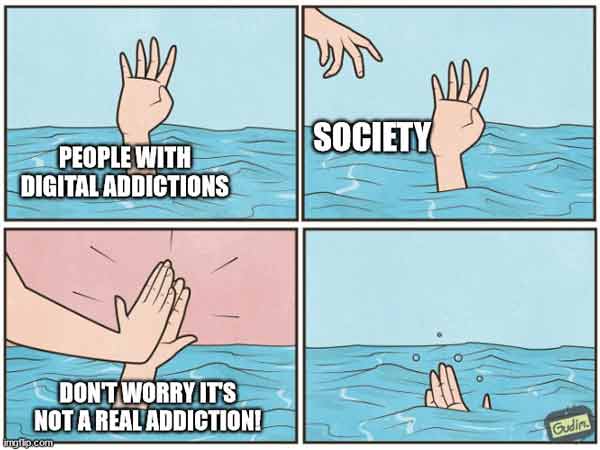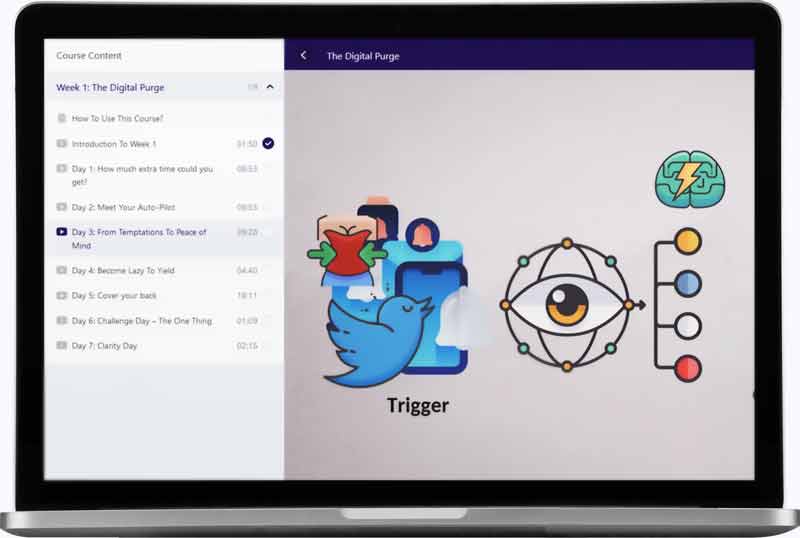Welcome to our digital detoxing series! A series on how to stop addictions to Fortnite,Facebook,Instagram,porn,Netflix, Youtube,Tinder… Find all the posts about digital addiction. Today, let’s talk about how to quit the handy addiction.

- What’s the handy addiction?
- Addiction to handy, a “real” addiction?
- What’s considered handy addiction
- How much handy is too much?
- Some Work and productivity addiction facts & statistics
- Symptoms & Causes of the handy addiction
- Why is handy so addictive?
- Possible causes of handy dependency
- Symptoms, Causes and Signs of handy addiction
- Problems, impacts & bad effects of handy
- Some benefits of handy
- health problems
- impact on brain & mental health
- impact on relationships
- How to stop & quit your handy addiction
- Main steps and solutions to break the handy addiction
- Best handy blocker apps & functionalities
- where to seek extra help?
- Conclusion
- To Go Further
- How to help someone with handy addiction
- Best books about Work and productivity addiction
- Research about Work and productivity addiction
What is the handy addiction?
About handy
Handy is an all-in-one tool for home maintenance, repairs and improvements. It provides access to experienced professionals who can help with any job, big or small.
Addiction to handy, a “real” addiction?
Officially an addiction?
First, let’s have a look to the DSM-5,the Diagnostic and Statistical Manual of Mental Disorders. Does it includes handy addiction?
No, handy addiction is not listed in the DSM-5.
So what means “handy addiction”?
Handy addiction is a term used to describe an excessive reliance on technology, specifically smartphones and other handheld devices. People who suffer from handy addiction may find it difficult to concentrate or stay productive without having their device with them. They may also feel anxious when their device is not available or when their battery runs low.
What is considered handy addiction?
- 1. Engaging in the activity more frequently or more intensely than intended.
- 2. Preoccupation with the activity,as evidenced by thinking about it when not engaged in it.
- 3. Loss of control over the activity,as evidenced by difficulty in stopping.
- 4. Withdrawal symptoms when not engaging in the activity,such as irritability, restlessness, and anxiety.
- 5. Tolerance,as evidenced by needing to engage in the activity more often or with more intensity in order to experience the same level of reward.
- 6. Continuing the activity even when it interferes with other important life activities such as work,school, or relationships.
- 7. Neglecting important life activities in favor of the activity.
- 8. Continuing the activity despite facing harmful repercussions such as financial,legal, or social consequences.
How much handy is too much?
It is hard to say how much time is too much when it comes to using a handy device. Everyone has different needs and preferences when it comes to technology, so it ultimately depends on the individual. If you find that you are spending too much time on your device, it may be helpful to set limits and take breaks to ensure that your usage remains healthy.
Some Work and productivity addiction facts & statistics

According to studies, work and productivity addiction, also known as workaholism, is a growing concern in many countries. Here are some statistics related to work and productivity addiction:
- 1. In a survey of 1,000 employees, 25% reported feeling addicted to work.
- 2. A study found that workaholism is associated with a higher risk of physical and mental health problems,including anxiety, depression, and sleep disorders.
- 3. According to a report,workaholics are more likely to suffer from burnout, job dissatisfaction, and turnover intentions.
- 4. The World Health Organization (WHO) recently classified workaholism as an official medical diagnosis, noting that it can have negative consequences on an individual’s health and well-being.
- 5. A study found that workaholics tend to work longer hours and take fewer breaks than their colleagues,which can lead to decreased productivity in the long run.
- 6. Workaholism can also have a negative impact on personal relationships,with workaholics reporting less time spent with family and friends.
- 7. According to a study,workaholism is more prevalent in high-income countries, such as the United States, Japan, and South Korea.
Overall, work and productivity addiction can have significant negative consequences on an individual’s health, well-being, and productivity. It is important to recognize the signs of workaholism and seek help if necessary.
Is the handy addiction widespread?
It is possible that some people may become addicted to using the platform due to its convenience and ease of use. It is important for individuals to use online services in moderation and seek help if they feel they may be developing an addiction.
Symptoms, Causes and Signs of handy addiction
Why is handy so addictive?
Handy is addictive because it offers a wide variety of tools and services that can be used to make life easier and more productive. It also has a user-friendly interface and is constantly updating with new features, making it an attractive and appealing app.
Additionally, people often find the convenience of being able to access the many services and tools that Handy offers appealing and find themselves using it more and more.
Possible causes of handy dependency
- 1. Social Pressure:Pressure from peers and society to have the latest technology can lead to addiction and overuse of the device.
- 2. Anxiety:People use their smartphones to help them cope with anxiety, but this can lead to reliance on the device and ultimately addiction.
- 3. Stress:Smartphones can be used as a distraction from daily stressors, which can lead to overuse.
- 4. Lack of Sleep:Smartphone use can lead to a lack of sleep, which can contribute to addiction.
- 5. Boredom:Smartphones can be used to fill time when there is nothing else to do, and can become a habit.
- 6. Poor Parental Involvement:If a parent is not involved in their child’s activity, it can lead to increased smartphone usage and addiction.
Signs & Symptoms of handy addiction
Now let’s see if you have the handy addiction problem.
- 1. You can’t resist checking out any new tools or supplies that come onto the market.
- 2. You’re always tinkering with something around the house.
- 3. You take on projects that other people would find daunting.
- 4. You have an extensive tool collection.
- 5. You can’t resist a good DIY challenge.
- 6. You are always dreaming up new ideas for projects.
- 7. You get a thrill out of finding new uses for old materials.
Problems, impacts & bad effects of handy: should you quit?

What are some benefits of handy
Pros of Handy:
- 1. Handy is a reliable,affordable, and convenient way to book cleaning, home repair, and improvement services.
- 2. Handy makes it easy to find experienced and reliable professionals who can help you complete your projects.
- 3. Handy provides customers with clear and transparent pricing,so you know exactly what you’ll pay before booking a service.
- 4. Handy offers a satisfaction guarantee,so you can be sure that the service you book will be completed to your satisfaction.
- 5. Handy offers a variety of payment options,including credit cards, PayPal, and Apple Pay.
- 6. Handy provides customer support via phone and email,so you can get help when you need it.
- 7. Handy is available in over 20 cities across North America,so you can find help no matter where you are.
But at the opposite, what can be some handy addiction problems addicts suffer from?
general health problems
- 1. Poor Posture:Spending too much time with your head bent down looking at your phone can cause a poor posture, leading to neck, back, and shoulder pain.
- 2. Eye Strain:Staring at your phone’s small screen can lead to serious eye strain and other vision problems.
- 3. Sleep Interference:The blue light emitted from your phone screen can interfere with your body’s natural sleep rhythm and cause difficulty sleeping.
- 4. Hearing Loss:Listening to music or videos at high volumes through earphones can lead to hearing loss.
- 5. Carpal Tunnel Syndrome:Prolonged use of your hands and fingers to type messages and scroll through apps can lead to carpal tunnel syndrome.
- 6. Stress:Constantly checking your phone and worrying about missing a text or call can lead to stress and anxiety.
handy and sleep disorder
No, Handy is a home cleaning and maintenance service and does not have the capability to create sleep disorders or problems. However, if you are experiencing sleep issues, it may be helpful to ensure that your sleeping environment is clean and well-maintained, which is where Handy can be of assistance.
Additionally, it is recommended to speak with a healthcare professional if you are experiencing persistent sleep problems.
handy affecting your brain & mental health: bad for brain and mental health?
Some effects of handy on your brain
- 1. Increased Stress Levels:Research has shown that the use of mobile phones can increase stress levels. The constant need to be connected to the internet, check emails, and respond to messages can lead to an increase in stress levels.
- 2. Reduced Concentration:The frequent use of mobile phones can have an impact on your concentration levels. Studies have found that people who use their phones while studying have lower scores on memory tests compared to those who do not use their phones.
- 3. Poor Sleep Quality:The blue light emitted from mobile phones can disrupt the natural sleep-wake cycle, leading to poor sleep quality.
- 4. Increased Risk of Depression:The increased use of mobile phones has been linked to an increased risk of depression. This is largely due to the fact that people tend to compare themselves to others, feel envious, and experience negative emotions when using their phone.
Some effects of handy on your mental health
- 1. Increased Stress Levels:The constant pressure of staying connected can increase stress levels, leading to anxiety and depression.
- 2. Reduced Attention Span:The constant distractions of notifications, emails, calls and messages can lead to a reduced attention span and make it difficult to concentrate on tasks.
- 3. Sleep Deprivation:The blue light from smartphones can disrupt sleep patterns, leading to fatigue and poor cognitive performance.
- 4. Isolation:Too much reliance on technology can lead to a sense of isolation, as people can become more isolated from their peers and family members.
- 5. Compulsive Behaviors:Constant checking of emails, social media updates and messages can lead to compulsive behaviors, which can further exacerbate mental health issues.
Does handy cause stress and anxiety?
This may be due to factors such as feeling overwhelmed by the device’s features and functions or the pressure to always be connected and responsive to notifications.
Additionally, excessive use of technology can contribute to a sedentary lifestyle and lack of physical activity, which can also lead to stress and anxiety. It is important to be mindful of our technology usage and take breaks when needed to prioritize our mental and physical health.
Can handy addiction lead to sadness and depression?

Yes, excessive use of technology and mobile devices can lead to addiction, and this addiction can lead to sadness and depression. Handy addiction can cause individuals to isolate themselves from social relationships, leading to loneliness and feelings of isolation. It can also interfere with sleep patterns, leading to fatigue and irritability. In some cases, addiction to hand-held devices can affect an individual’s work or school performance, leading to feelings of failure and low self-esteem. Furthermore, the constant stimulation from electronic devices can affect the brain’s reward system, leading to a reduction in dopamine production, which can cause depression. Therefore, it’s essential to use technology in moderation and take breaks to maintain a healthy balance between digital and real-life experiences.
Dopamine and handy
Dopamine is a neurotransmitter that is responsible for many important functions in the brain, such as regulating movement, motivation, and reward. It is often referred to as the “feel-good” neurotransmitter because it plays a major role in our ability to experience pleasure and happiness.
Handy, on the other hand, refers to something that is useful or convenient. It is often used to describe tools or objects that can be easily carried and used for various tasks.
There is no direct connection between dopamine and handy, as they are two very different things. However, it is possible that certain handy tools or objects can trigger the release of dopamine in the brain by providing a sense of satisfaction or accomplishment. For example, completing a DIY project using handy tools can give a sense of accomplishment and trigger the release of dopamine, leading to feelings of pleasure and happiness.
handy effects on Focus, productivity, attention span, academic performance…
We can provide a general answer to how certain factors can affect focus, productivity, attention span, and academic performance.
There are many factors that can affect focus, productivity, attention span, and academic performance. Some of the most common factors include:
- 1. Sleep:Lack of sleep can lead to fatigue, irritability, and decreased cognitive function, which can all negatively impact academic performance.
- 2. Nutrition:A balanced and healthy diet is essential for maintaining energy levels and focus. Poor nutrition can lead to fatigue and decreased cognitive function.
- 3. Exercise:Regular exercise can increase blood flow and oxygen to the brain, which can improve cognitive function and academic performance.
- 4. Stress:High levels of stress can impair cognitive function and lead to decreased motivation and productivity.
- 5. Distractions:Distractions such as social media, TV, or noise can disrupt focus and attention span, leading to decreased productivity and academic performance.
Therefore, it is essential to maintain a healthy lifestyle, manage stress, and minimize distractions to optimize focus, productivity, attention span, and academic performance.
A word about ADHD and handy
People with ADHD may interact with handy differently depending on their individual symptoms and coping mechanisms. For example, someone with ADHD may struggle with organizing and completing tasks, so they may rely more heavily on handy to help them stay on track. Alternatively, someone with ADHD may struggle with impulsivity and hyperactivity, which could impact their ability to use handy in a consistent and effective manner. Ultimately, the interaction between a person with ADHD and handy will depend on many factors, including the severity of their symptoms, their personal preferences, and their individual experiences.
affecting your relationships
handy and self-esteem
Being handy can have a positive impact on self-esteem. When someone is able to fix something or complete a DIY project, they may feel a sense of accomplishment and pride in their abilities. This can lead to increased self-confidence and a belief in one’s own skills and capabilities.
Additionally, being able to handle tasks and repairs on their own can also make someone feel more self-sufficient and independent, which can further boost their self-esteem. Overall, being handy can be a source of personal satisfaction and confidence, which can have a positive impact on one’s mental well-being.
handy addiction leads to isolation and loneliness?
.jpg)
Yes, addiction to using handheld devices can lead to isolation and loneliness. Excessive use of handheld devices can lead to a lack of face-to-face interaction, which is crucial for maintaining social connections and developing meaningful relationships. Individuals who are addicted to their devices may withdraw from real-life social interactions and instead spend most of their time on their devices, causing them to feel isolated and disconnected from others.
Additionally, the constant need to check and use devices can lead to a lack of focus and productivity, which can further contribute to feelings of loneliness and isolation.
Effects of handy on your relationship
Positive effects of Handy on your relationship:
- 1. Increased efficiency:By using Handy, you can save time and effort that you would have otherwise spent on household chores. This can help reduce stress and give you more time to spend with your partner.
- 2. Improved communication:Handy can help facilitate communication between you and your partner about household tasks, schedules, and preferences. This can lead to better teamwork and a more harmonious relationship.
- 3. More free time:By using Handy, you can free up time for activities that you and your partner enjoy doing together. This can help strengthen your bond and create more positive memories.
Negative effects of Handy on your relationship:
- 1. Dependency:If you rely too much on Handy, it can create a sense of dependency on technology, which can detract from your ability to communicate and work together as a team.
- 2. Disagreements about tasks:If you and your partner have different expectations about the use of Handy, it can lead to disagreements and conflicts about who should do what tasks.
- 3. Reduced intimacy:If you spend too much time using Handy, it can take away from quality time that you might have spent with your partner. This can lead to a decrease in intimacy and emotional connection.
How To Stop & quit Your handy Addiction
Finally you think you are addicted to handy and you are wondering how to quit it? How to break and overcome your cravings for handy?
Here are the best solutions, steps, supports, resources and help you can get to treat your handy addiction.
Main steps and solutions to break the handy addiction
- 1. Recognize the problem:Acknowledge that you have a problem with handy addiction.
- 2. Identify triggers:Identify the situations and activities that cause you to reach for your device.
- 3. Set limits:Establish rules and limits on when and how you use your device.
- 4. Find alternatives:Find activities that help to replace the time you would spend on your device.
- 5. Track your progress:Monitor your progress and celebrate successes.
- 6. Seek help:Consider professional help if necessary.
Actually, that’s what most documentation out there is about… However, quitting a digital addiction can be a bit trickier than that.
So our team, after testing many ways, designed a bulletproof way to overcome them. Here are some clear and practical steps that are very powerful to quit a digital addiction, including handy:
1. Purge temptations: Get rid of handy
First, cleaning your life from temptations is much easier than resisting to them. Disable or delete your handy accounts, change the password and hide it somewhere you can’t access easily, keep your phone / computer far away… Out of sight out of mind.
Here is a video from our course the The Digital Purge. on how to add resistance to your temptations, so you become so lazy to engage with them that you give them up:







